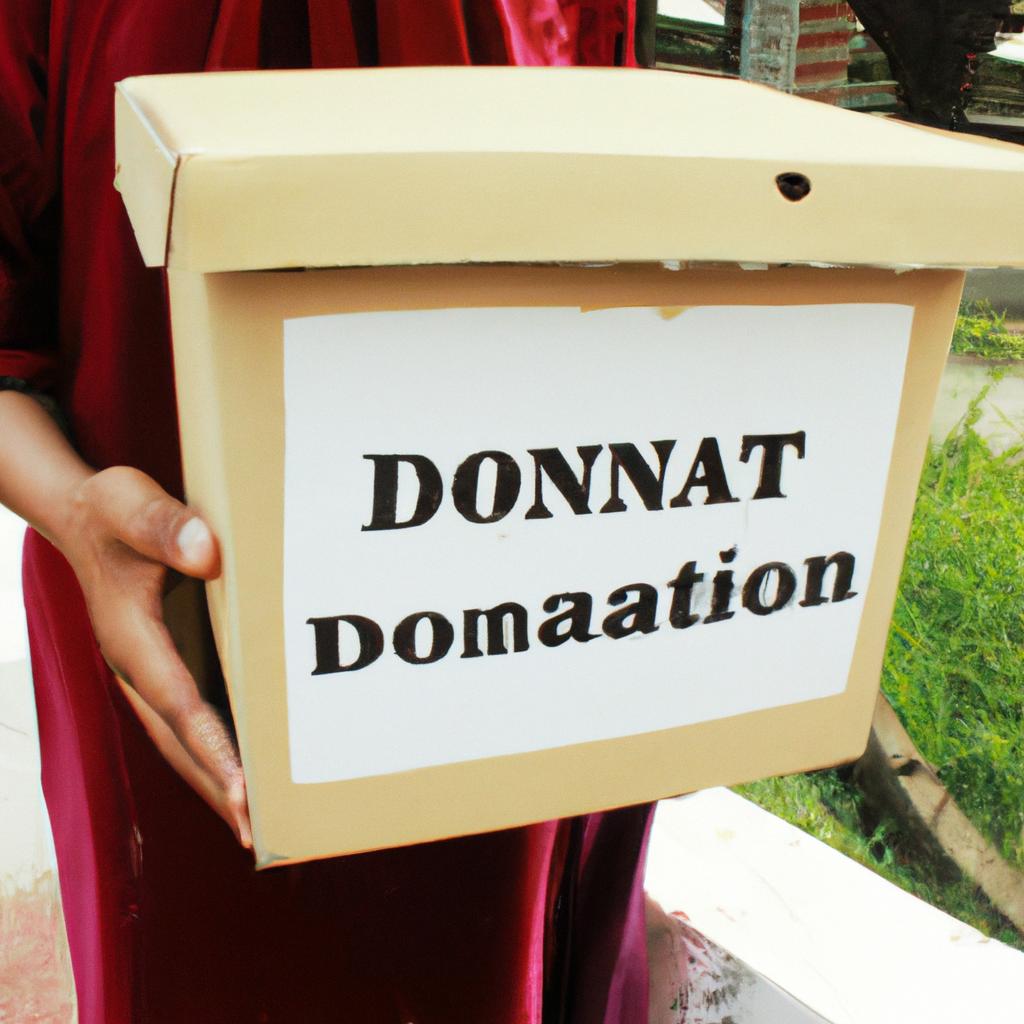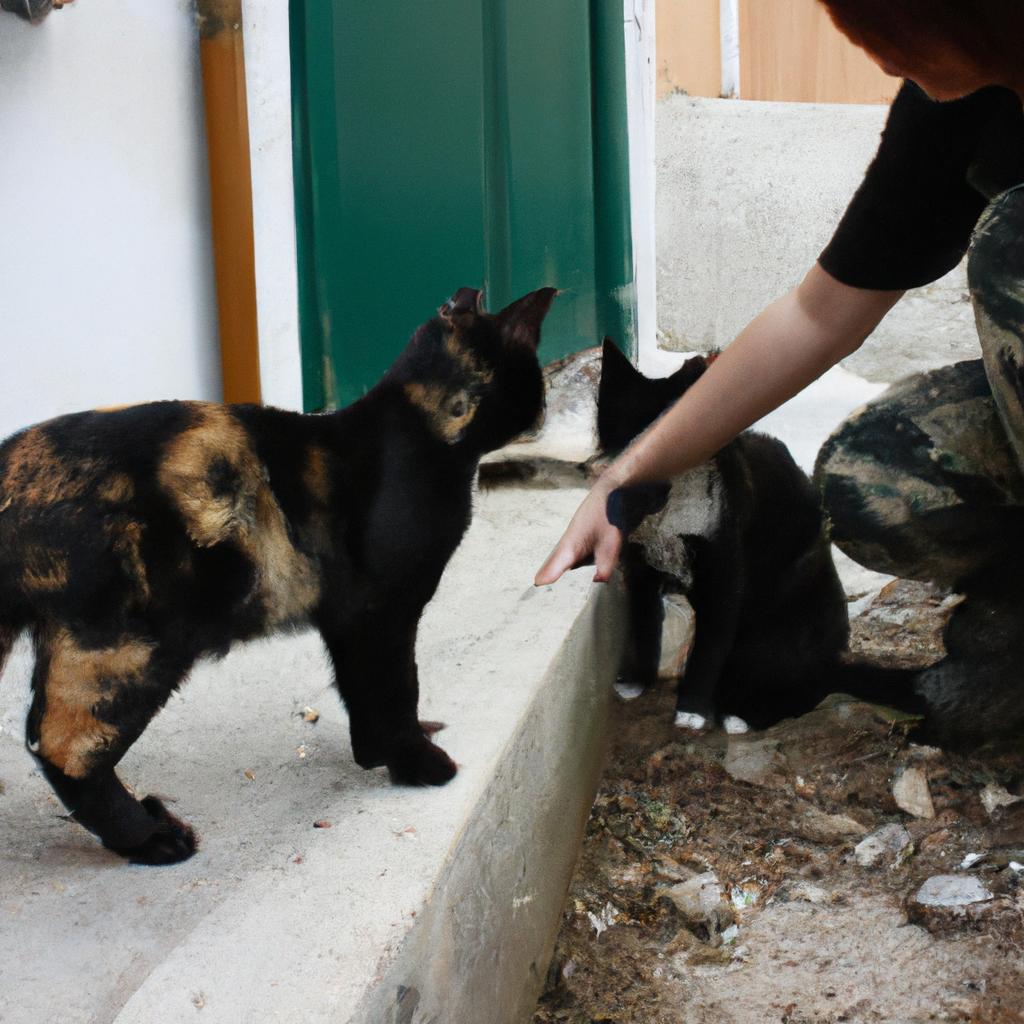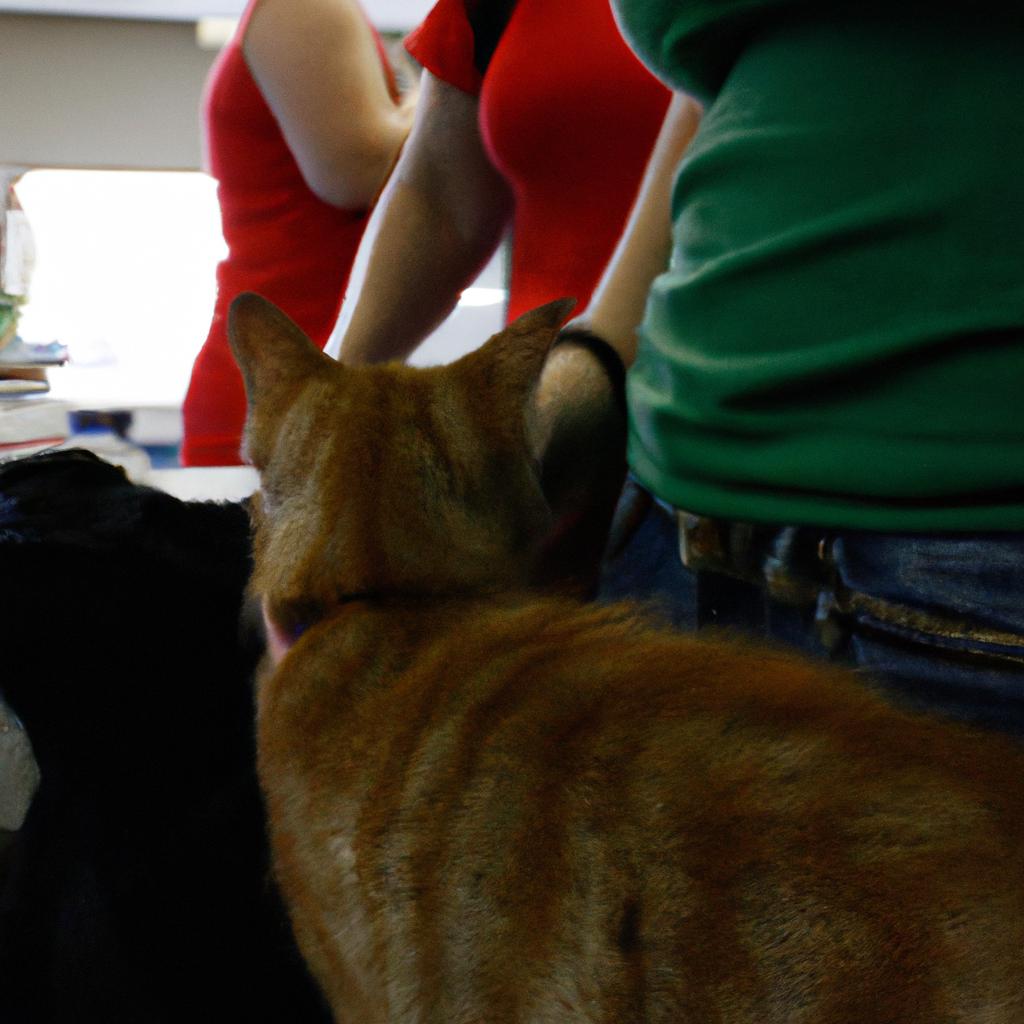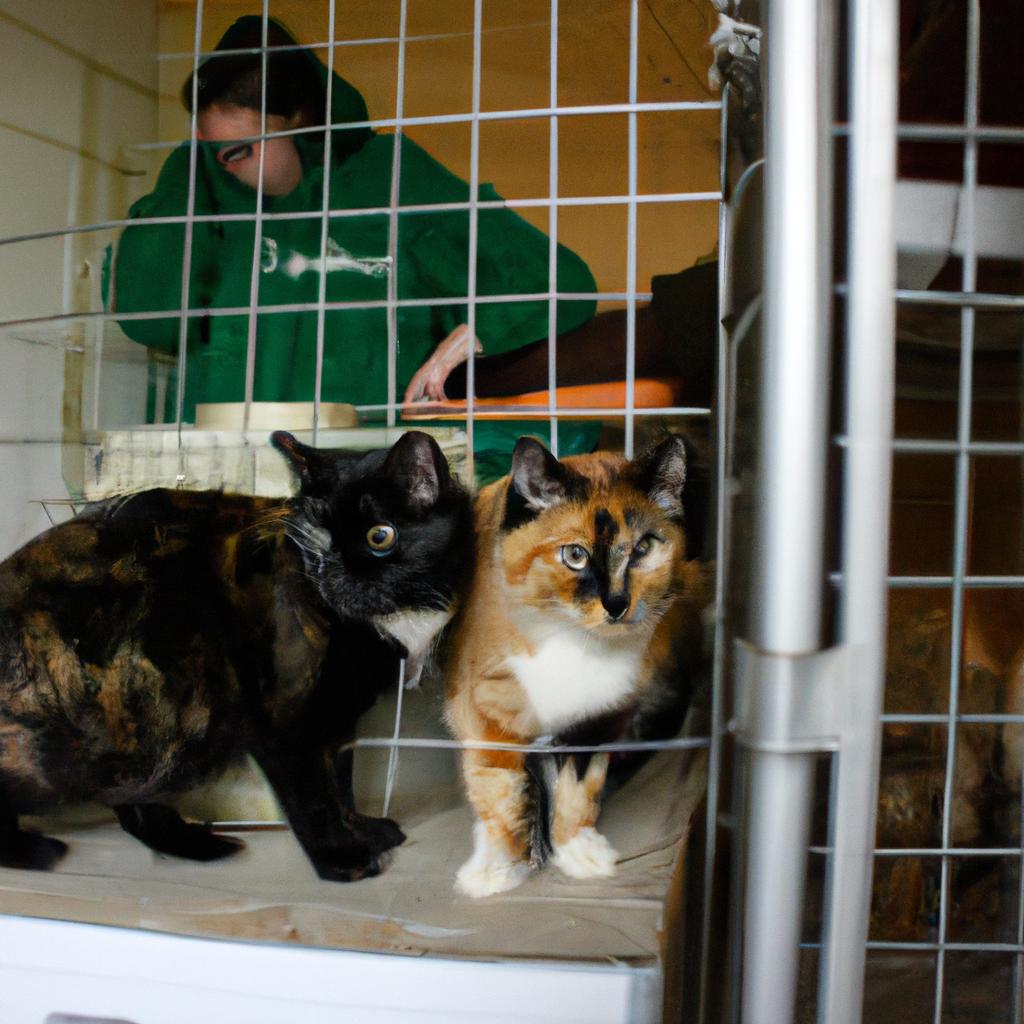In the world of animal rescue, cat rescues face unique challenges when it comes to fundraising. Limited financial resources and a constant influx of cats in need create an ongoing need for sustainable funding sources. One effective strategy that has proven successful is leveraging volunteer opportunities as a means of generating funds. For instance, imagine a hypothetical scenario where a local cat rescue organization partners with a local business to host a “Purrfect Pet Adoption Day” event. Volunteers from both the organization and the business collaborate to organize various activities such as pet adoptions, raffles, and interactive games for attendees. Through this collaborative effort, not only does the cat rescue raise much-needed funds but also raises awareness about their cause.
Implementing fundraising strategies tailored specifically to the needs of cat rescues can significantly contribute to their financial stability and ability to continue providing care for vulnerable feline populations. By capitalizing on volunteer opportunities, organizations can tap into the passion and dedication of individuals who share their commitment to animal welfare. This approach allows them to harness human resources while simultaneously raising necessary funds through events such as adoption drives, fundraisers at local businesses, or even online crowdfunding campaigns. By doing so, cat rescues can build strong community partnerships and engage supporters in meaningful ways that go beyond simple donations. This not only helps sustain their operations but also fosters a sense of community involvement and shared responsibility for the welfare of cats in need.
In addition to volunteer-driven fundraising events, cat rescues can explore other avenues to generate funds. These may include grant applications targeting animal welfare organizations, partnerships with local veterinarians or pet supply stores for sponsorship opportunities, and collaborations with other non-profit organizations that align with their mission. By diversifying their funding sources, cat rescues can mitigate the risks associated with relying solely on individual donations or limited resources.
Furthermore, leveraging social media platforms and online networks can significantly expand a cat rescue’s reach and donor base. Creating engaging content, sharing heartwarming stories about successful adoptions, and highlighting the impact of their work are effective ways to connect with potential supporters. Through these digital channels, cat rescues can also launch crowdfunding campaigns to raise funds for specific needs such as medical treatments or facility improvements.
Ultimately, it is essential for cat rescues to adopt a proactive approach in fundraising by continuously seeking out new opportunities and adapting strategies based on their unique circumstances. With careful planning, creativity, and support from volunteers and the community at large, cat rescues can overcome financial challenges and continue making a positive difference in the lives of countless feline companions.
Understanding the Importance of Fundraising in Cat Rescue
Imagine a scenario where a local cat rescue organization is struggling to meet their financial needs. With limited resources and increasing expenses, they are unable to provide essential medical care, food, and shelter for the cats under their care. This case study serves as a compelling example of why fundraising plays a crucial role in supporting cat rescue efforts. In this section, we will explore the significance of fundraising in cat rescue and its impact on ensuring the well-being of these vulnerable animals.
The Role of Fundraising:
-
Providing Financial Support:
Fundraising serves as an indispensable source of financial support for cat rescue organizations. Through various initiatives such as events, campaigns, and donor partnerships, these organizations can raise funds necessary to cover veterinary costs, spaying/neutering procedures, vaccinations, and general care for rescued cats. Without adequate funding, these vital services would be severely compromised or even inaccessible. -
Expanding Outreach Efforts:
In addition to providing direct financial support, effective fundraising strategies help increase awareness about cat rescue organizations’ missions and goals. By engaging communities through events or online platforms, these organizations can educate the public about responsible pet ownership, promote adoption opportunities, and disseminate information regarding stray animal control programs. Such outreach initiatives not only create avenues for potential donations but also contribute towards building compassionate societies that prioritize animal welfare. -
Fostering Volunteer Engagement:
Successful fundraising endeavors often involve volunteers who dedicate their time and skills to organizing events or assisting with donation drives. These volunteer opportunities enable individuals from diverse backgrounds to actively participate in supporting cat rescue efforts while fostering a sense of community engagement and responsibility. The collaborative nature of volunteering strengthens connections between people passionate about animal welfare causes while amplifying the collective impact achieved through fundraising activities. -
Enhancing Sustainability:
By diversifying revenue streams through strategic fundraising approaches, cat rescue organizations can achieve long-term sustainability rather than relying solely on sporadic donations. This sustainability ensures that the organizations can continue to provide ongoing care and support for rescued cats, reducing their vulnerability and improving their chances of finding forever homes.
In conclusion, fundraising serves as a lifeline for cat rescue organizations, enabling them to fulfill their missions effectively. From providing financial support to expanding outreach efforts and fostering volunteer engagement, effective fundraising strategies play an instrumental role in ensuring the well-being of rescued cats. In the subsequent section, we will delve into identifying target donor groups for effective fundraising, building upon the understanding established here.
Next Section: Identifying Target Donor Groups for Effective Fundraising
Identifying Target Donor Groups for Effective Fundraising
In the previous section, we explored the vital role that fundraising plays in cat rescue organizations. Now, let’s delve into the strategies for identifying target donor groups to maximize the effectiveness of your fundraising efforts.
To illustrate this point, consider a hypothetical case study of a local cat rescue organization called “Pawsitive Purrs.” Pawsitive Purrs aims to raise funds to expand their shelter facility and provide better care for rescued cats. By identifying and targeting specific donor groups, they can increase their chances of success.
One effective strategy is to engage with local businesses that have an affinity for animal welfare causes. These businesses may be willing to donate a percentage of their sales or sponsor events organized by Pawsitive Purrs. Establishing partnerships with such entities not only brings financial support but also raises awareness about the organization’s mission among a wider audience.
Additionally, reaching out to individual donors who are passionate about feline companionship can yield significant contributions. This could involve hosting adoption drives at community events where potential adopters can learn more about the organization and make donations on-site. Utilizing social media platforms like Facebook and Instagram can help connect with these individuals and share heartwarming stories about successfully rescued cats.
- Every dollar donated helps save lives and provides essential medical care.
- Your contribution contributes directly towards helping abandoned cats find forever homes.
- With your support, Pawsitive Purrs can continue rescuing vulnerable kittens from dangerous situations.
- Donating allows you to become part of a compassionate community dedicated to improving feline welfare.
Furthermore, incorporating a table showcasing some key statistics related to cat rescue efforts can further resonate with readers’ emotions:
| Statistic | Impact |
|---|---|
| Number of cats euthanized annually | Raises urgency for immediate action |
| Percentage of abandoned cats adopted | Highlights the need for rescue organizations |
| Average cost per cat for medical care | Demonstrates financial challenges faced |
| Success rate in finding forever homes | Reinforces the positive impact achieved |
In conclusion, identifying target donor groups is crucial for effective fundraising in cat rescue organizations. Engaging with local businesses and individual donors passionate about feline welfare can significantly boost contributions. By leveraging emotional appeals through bullet points and incorporating impactful statistics in a table, organizations like Pawsitive Purrs can effectively communicate their mission to potential supporters.
Transitioning into the subsequent section on “Implementing Online Donation Platforms and Campaigns,” we will explore how digital platforms provide an avenue to reach a broader audience and facilitate convenient donation processes.
Implementing Online Donation Platforms and Campaigns
In the quest to secure sufficient funding for cat rescue operations, it is crucial to explore various avenues and partnerships that can bring about significant financial support. One example of a successful fundraising strategy is through leveraging corporate partnerships. By collaborating with businesses that align with the mission and values of cat rescue organizations, substantial funds can be raised while also increasing public awareness.
One effective way to forge corporate partnerships is by highlighting the mutual benefits derived from such collaborations. Cat rescue organizations can emphasize the positive impact these partnerships have on local communities, as well as their potential contributions towards improving corporate social responsibility efforts. For instance, let’s consider a hypothetical case study where a popular pet supply store partners with a cat rescue organization. The store could offer exclusive discounts to customers who make donations or volunteer at the organization, thereby incentivizing community involvement and boosting sales simultaneously.
To further illustrate how corporate partnerships can benefit cat rescue initiatives, we present a bullet point list showcasing potential advantages:
- Access to larger donor networks
- Increased visibility and brand exposure
- Financial contributions through sponsorships or grants
- In-kind donations such as supplies or resources
Additionally, incorporating visual aids like tables can evoke an emotional response among readers. Below is an example table illustrating the impact of recent corporate partnerships in terms of funds raised:
| Company | Partnership Contribution | Funds Raised (USD) |
|---|---|---|
| Pet Food Co. | Sponsorship & Promotions | $10,000 |
| Veterinary Clinic | Pro-bono medical services | $5,500 |
| Retail Chain | Cause-related marketing | $7,200 |
| Tech Firm | Employee Matching Program | $3,800 |
By actively seeking out strategic alliances with compatible corporations and effectively communicating shared goals and objectives, cat rescue organizations can unlock new sources of funding and support. These partnerships not only provide financial resources but also help build stronger community ties and amplify the mission of cat rescue efforts.
Transitioning into the subsequent section about “Organizing Fundraising Events to Engage the Community,” it becomes evident that organizing events is another vital aspect of successful fundraising endeavors.
Organizing Fundraising Events to Engage the Community
Transitioning from the previous section on implementing online donation platforms and campaigns, this next section will focus on organizing fundraising events to engage the community in cat rescue efforts. By hosting various events, organizations can not only raise funds but also increase awareness about their cause, attract potential donors, and foster a sense of community involvement.
To illustrate the impact of fundraising events, let’s consider a hypothetical case study: The ABC Cat Rescue Organization decided to host a “Paws for a Cause” carnival in their local community park. This event featured games, food vendors, live entertainment, and opportunities to interact with adoptable cats. Through effective planning and promotion strategies, they were able to gather significant support from both individuals and businesses in the area.
One effective tool that can be used during these events is incorporating emotional appeal through bullet points:
- Highlight heartwarming success stories of rescued cats finding loving homes.
- Showcase before-and-after photos demonstrating the transformation of neglected or abused cats into healthy companions.
- Share statistics about the number of lives saved through donations received at past events.
- Emphasize how each contribution directly supports medical care, shelter facilities, and adoption programs for homeless felines.
Additionally, utilizing tables can further evoke an emotional response from attendees by presenting information in a visually appealing manner. Here is an example table showcasing different sponsorship options available at fundraising events:
| Sponsorship Level | Benefits | Donation Amount |
|---|---|---|
| Gold | Logo placement on event banners | $1,000 |
| Silver | Recognition in event program | $500 |
| Bronze | Social media shout-out | $250 |
| Friend | Mention during opening remarks | $100 |
By offering diverse sponsorship levels with corresponding benefits, organizations provide opportunities for businesses of all sizes to get involved while simultaneously contributing to their marketing objectives.
In conclusion, organizing fundraising events presents a valuable opportunity for cat rescue organizations to engage their community, raise funds, and increase awareness. Through emotional appeal techniques like success stories and visually engaging tools such as bullet points and tables, these events can effectively communicate the importance of supporting feline welfare efforts. The next section will explore another avenue for garnering support by building partnerships with local businesses.
Building Partnerships with Local Businesses for Support
Transitioning from organizing fundraising events, another effective strategy is building partnerships with local businesses. By collaborating with businesses in your community, you can tap into their resources and support to further your cat rescue efforts. One hypothetical example of such collaboration could involve partnering with a pet store to host an adoption day event where potential adopters can meet rescued cats while also browsing pet supplies.
Building partnerships with local businesses offers several benefits:
-
Increased visibility and reach:
- Collaborating with established businesses allows you to tap into their customer base and raise awareness about your organization.
- Through joint marketing efforts, both parties can promote each other’s mission, increasing exposure and potentially attracting new volunteers or donors.
-
Access to resources:
- Local businesses often have access to various resources that can aid in fundraising efforts.
- They may be willing to provide financial contributions, donate products or services as raffle prizes, or offer discounts on purchases made by supporters of your organization.
-
Mutual beneficial relationships:
- Partnering with local businesses fosters a sense of community engagement and demonstrates corporate social responsibility.
- These collaborations allow businesses to align themselves with a cause they care about, enhancing their reputation among customers who value supporting charitable organizations.
To illustrate the impact of building partnerships within the community, consider the following table showcasing successful collaborations between a cat rescue organization and different types of local establishments:
| Business Type | Collaboration Details | Outcome |
|---|---|---|
| Veterinary Clinic | Providing discounted vaccinations for adopted cats | Reduced medical expenses |
| Coffee Shop | Hosting weekly “Adopt-A-Cat” events | Increased adoptions |
| Pet Grooming Salon | Offering free grooming services for fostered cats | Enhanced adoptability |
| Bookstore | Donating a portion of book sales during an event | Financial contribution to rescue |
By leveraging these partnerships, cat rescue organizations can amplify their impact and secure valuable resources that contribute to the well-being of rescued cats. Building relationships with local businesses not only benefits your organization but also strengthens ties within the community.
By establishing strong connections with local businesses, you lay the foundation for creating a donor appreciation program to encourage continued giving. This approach recognizes the importance of both financial contributions and ongoing support from generous individuals in sustaining your mission.
Creating a Donor Appreciation Program to Encourage Continued Giving
Transitioning from the previous section, where we explored the importance of building partnerships with local businesses as a fundraising strategy in cat rescue efforts, this section will delve into another crucial aspect – creating a donor appreciation program to encourage continued giving. To illustrate these concepts further, let’s consider the hypothetical case study of Pawsome Haven Cat Rescue.
Pawsome Haven Cat Rescue is a non-profit organization dedicated to rescuing and rehoming stray cats in their community. In order to sustain their operations and provide adequate care for the feline residents, they have actively sought support from local businesses through various partnership initiatives. By collaborating with like-minded establishments, such as pet supply stores and veterinary clinics, Pawsome Haven has not only gained financial backing but also access to valuable resources and expertise.
To emphasize the significance of cultivating relationships with local businesses, here are some key benefits:
- Increased funding: Partnering with businesses allows nonprofits like Pawsome Haven to secure additional funds through donations or sponsorships. These contributions can be instrumental in covering expenses related to medical treatments, food supplies, and shelter maintenance.
- Enhanced visibility: Collaborating with reputable businesses helps raise awareness about the cat rescue organization within the community. This increased exposure can attract more volunteers, potential adopters, and even other business sponsors.
- Shared resources: Local businesses often possess unique assets that can greatly benefit cat rescue organizations. For instance, partnering with a veterinary clinic could result in discounted medical services or free spaying/neutering procedures for rescued cats.
- Mutual promotion: Establishing partnerships provides an opportunity for both parties involved to gain mutual promotional benefits. Nonprofits can highlight their corporate sponsors on their website or social media platforms while simultaneously promoting the products or services offered by these businesses.
In addition to these advantages, implementing a well-designed donor appreciation program becomes pivotal in fostering long-term relationships between nonprofit organizations like Pawsome Haven and their supporters.
| Category | Benefits | Example |
|---|---|---|
| Financial Rewards | Tax deductions for businesses, increased customer loyalty | Sponsorship by XYZ Pet Mart |
| Social Responsibility | Positive brand image, community involvement | Collaboration with ABC Clinic |
| Networking Opportunities | Access to potential donors or volunteers | Joint event with DEF Bank |
| Skill Development | Employee engagement through volunteering initiatives | Team-building at GHI Corporation |
In conclusion, building partnerships with local businesses is a strategic approach that can benefit cat rescue organizations such as Pawsome Haven in multiple ways. By establishing these collaborations, nonprofits gain financial support, access to resources, enhanced visibility within the community, and mutual promotional opportunities. Furthermore, creating a donor appreciation program solidifies relationships with supporters while simultaneously encouraging continued giving. Through this holistic approach, cat rescue organizations can ensure sustainable funding and make a lasting impact on feline welfare in their communities.




